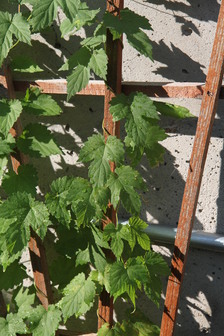Back to Tour: Medicinal Plants Tour
|
Humulus lupulus var. neomexicanus Common Hops |
Denver Botanic Gardens
Gardens Navigator 
|
|
Accession Number: 121396*1 Map | |
| More about Humulus lupulus var. neomexicanus | |
| TOUR DETAILS |
Medicinal uses: Medicinally, hops is known to have sedative, soporific (inducing sleep), anti-spasmodic, aromatic, diuretic, nervine and analgesic properties. The bitter taste and properties of hops stimulates digestion. The female cones are used and can soothe muscles and promote good night’s sleep. Scientists have found that hops may also ease menopausal side effects, such as hot flashes, night sweats and insomnia. Hops is also a galactagogue (promoting breast milk production) and has estrogenic properties. For this reason, it should not be given to children who haven’t yet hit puberty. Mythology/Folklore: Let’s set the record straight: beer is not made from hops. Beer is actually made from barley and other grains and merely flavored with hops. It is the chemicals in hops that give beer its foam and bitter taste. The Latin name lupulus was given by the ancient Romans, meaning “wolf,” or “little wolf.” Like wolves circling their prey to eat them, so too the Romans thought the hops vines circled trees to strangle them. The word “hops” comes from the Anglo-Saxon hoppan, meaning “to climb.” Hops had been used for centuries before becoming famous in beer-making. Many Native Americans used the herb to treat pain and insomnia. Even King George III (aka the king who lost America) is said to have slept on a pillow stuffed with hops to ease his porphyria, a condition that can cause mental illness. Species within the hops genus are closely related to, and somewhat smell like, cannabis. Medicinal recipe: Hops Sleep Pillow. Pour 1 cup of fresh dried hop cones into a cotton or drawstring satin sachet bag. Cinch the drawstring and tie tightly. Culture: (from Blake Burger, staff horticulturist): “To ensure the best success with growing hops, plant a rhizome rather than growing from seed. A hops rhizome should be planted in early spring, as soon as the soil can be worked. Once you notice sprouts rising from the soil, pick the strongest and healthiest and start to train up a trellis. Cut back the weaker ones. Once established, water several times a week. Keep the base of the plant relatively thinned out to prevent powdery mildew.” |
| LOCATION GROUP | Parking Garage; York St. |
| FAMILY NAME | Hemp Family |
| FAMILY | Cannabaceae |
| ACCESSION DATE |
June 28, 2012 (When this plant was acquired and registered in the database) |
| FRUIT COLOR | green |
| USDA HZ | 4 (Coldest Zone Where Hardy) |
| HABIT | Herbaceous (Non-woody); Vine |
Location Map for 121396*1 Humulus lupulus var. neomexicanus
Map Help

© Denver Botanic Gardens, 1007 York Street, Denver, CO 80206
Photography © Denver Botanic Gardens

Powered by







 E-mail
E-mail